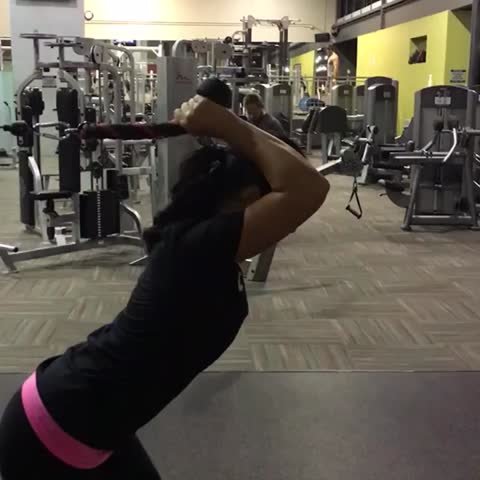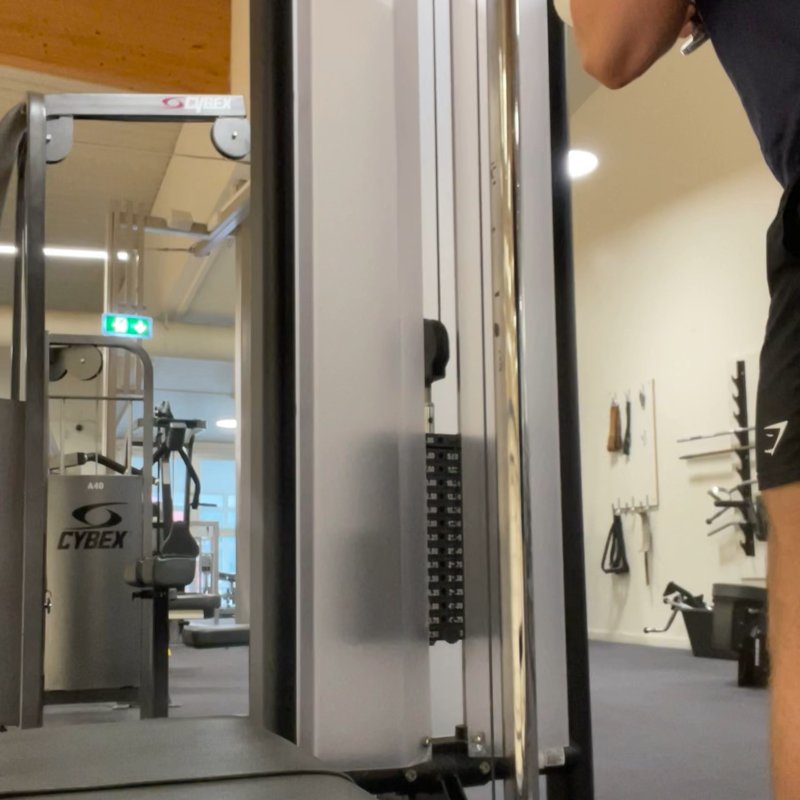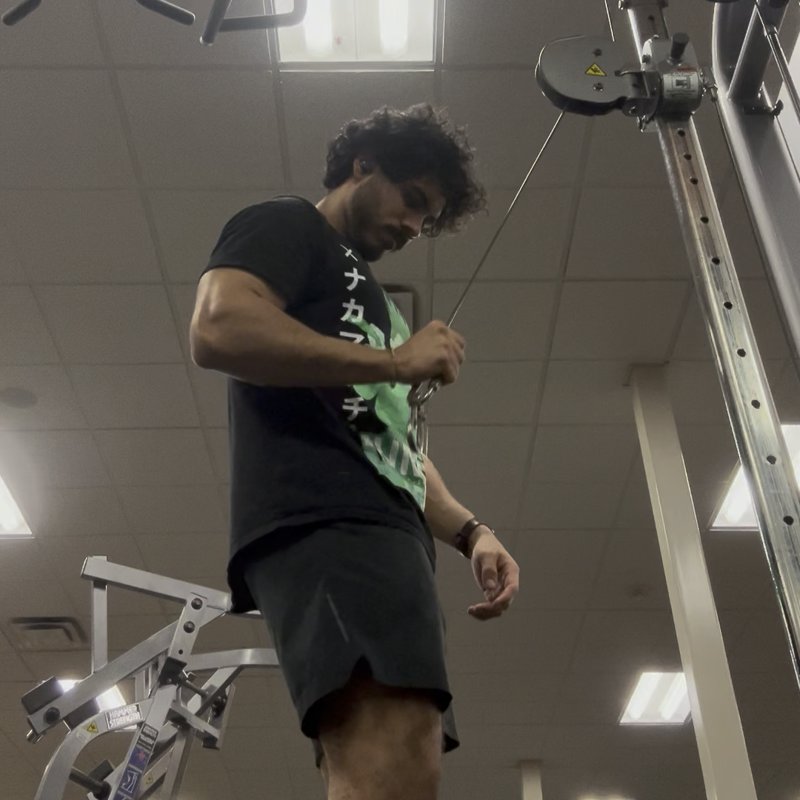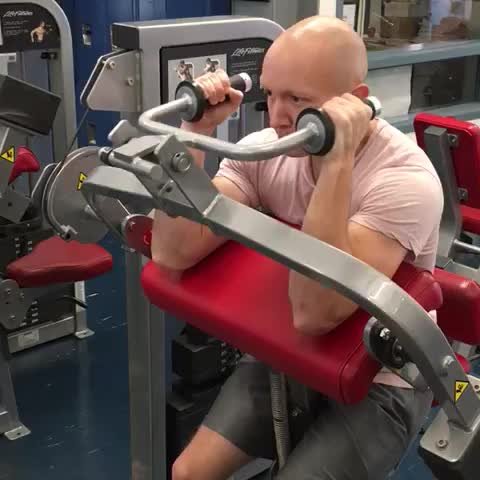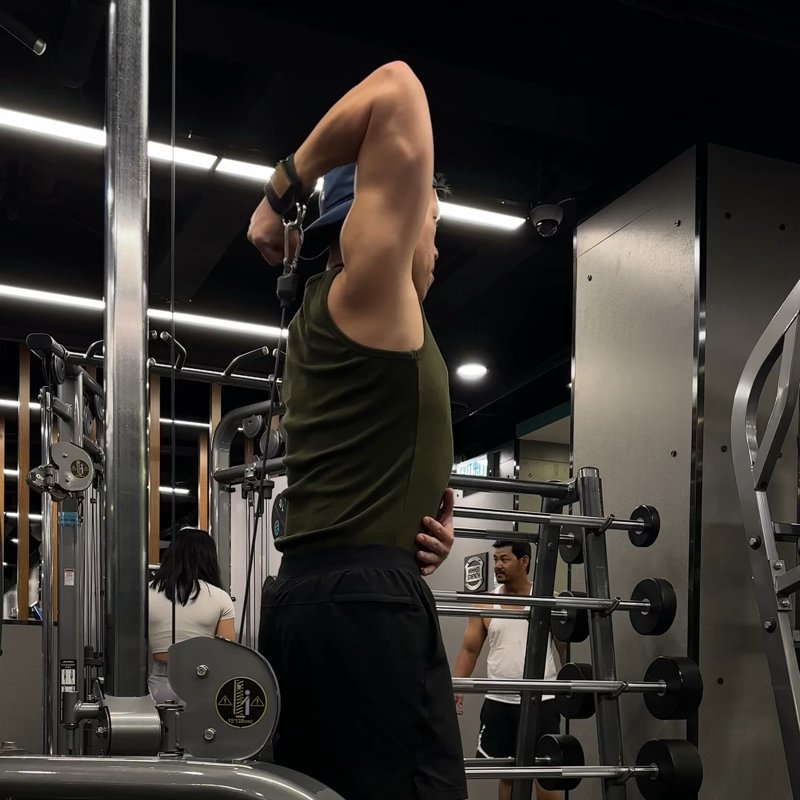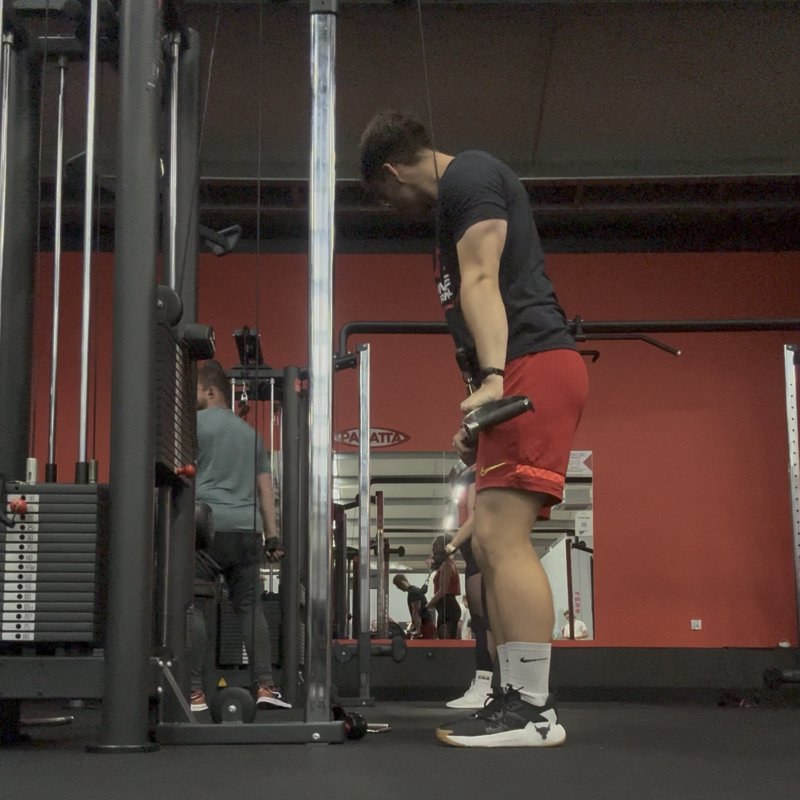Dumbbell Skull Crusher: The Ultimate Guide
The Dumbbell Skull Crusher is an isolation exercise performed lying on a bench that primarily targets all three heads of the triceps muscle, with particular emphasis on the lateral and medial heads.
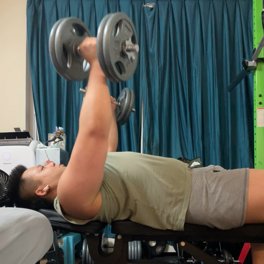
Quick Facts
Key Benefit
Triceps hypertrophy and strength with independent arm training
Primary Muscles
Triceps
Secondary Muscles
Abdominals, Anterior Deltoids, Forearms, Pectoralis Major
Equipment
dumbbells, flat bench (optional), incline bench (optional)
Difficulty
Intermediate
Type
Isolation
In This Guide
Ready to master the Dumbbell Skull Crusher?
Track your progress, see improvements over time, and build strength consistently.
Download GravitusThe Dumbbell Skull Crusher is an effective isolation exercise that directly targets the triceps brachii—the three-headed muscle that makes up the bulk of the upper arm's back portion. Also known as lying triceps extensions, this exercise derives its colorful name from the movement pattern where the weight is lowered toward the forehead or "skull." While similar to its barbell counterpart in basic mechanics, the dumbbell variation offers several unique advantages, including independent arm movement that can identify and address strength imbalances, a more natural range of motion that accommodates individual arm lengths and joint structures, and the ability to rotate the wrists slightly during execution for enhanced comfort. The triceps muscle plays a crucial role in arm aesthetics, making up approximately two-thirds of upper arm mass, and contributes significantly to performance in pressing movements like bench press, overhead press, and push-ups. By specifically isolating this muscle group through exercises like the dumbbell skull crusher, you can develop greater arm size, strength, and definition. Whether your goal is to build more impressive arms, improve lockout strength in pressing movements, or simply add an effective isolation exercise to your upper body routine, the dumbbell skull crusher delivers targeted stimulation in a format that can be scaled for lifters of various experience levels.
Benefits of Dumbbell Skull Crushers
The dumbbell variation offers several unique advantages compared to other triceps extension exercises.
Independent Arm Training
Using separate dumbbells allows each arm to work independently, helping identify and correct strength imbalances between sides.
Natural Range of Motion
The free movement of dumbbells accommodates individual limb lengths and joint structures, potentially reducing elbow and wrist strain.
Wrist Position Flexibility
Dumbbells allow for a neutral or slightly rotated wrist position, which many lifters find more comfortable than the fixed pronation required with a straight bar.
Increased Stabilization
Managing two separate weights requires greater stabilization from supporting muscles, potentially increasing overall engagement.
Progressive Overload Precision
Weight can be increased in smaller increments compared to barbells, allowing for more gradual and sustainable progression.
Proper Form & Technique
Setup
- Select an appropriate pair of dumbbells that challenge you but allow for proper form.
- Lie on a flat bench with your feet planted firmly on the floor for stability.
- Hold a dumbbell in each hand with a neutral grip (palms facing each other) or a pronated grip (palms facing forward).
- Extend your arms perpendicular to the floor, positioning the dumbbells directly above your shoulders.
- Keep your wrists straight and aligned with your forearms to minimize strain.
- Maintain a neutral spine position with a natural arch in your lower back.
- Keep your upper arms fixed and perpendicular to the floor throughout the entire movement.
- Engage your core to stabilize your torso and maintain proper position on the bench.
Movement
- Begin by taking a deep breath and bracing your core.
- Keeping your upper arms stationary and perpendicular to the floor, slowly bend at the elbows to lower the dumbbells.
- Lower the weights in an arc-like motion toward your forehead or just behind your head, depending on comfort and shoulder mobility.
- Maintain control throughout the lowering (eccentric) phase, taking approximately 2 seconds.
- Continue lowering until you feel a significant stretch in your triceps, typically when your forearms approach parallel to the floor.
- Pause briefly at the bottom position to eliminate momentum and emphasize the stretch.
- Contract your triceps to extend your elbows and press the dumbbells back up to the starting position.
- Focus on pushing through your pinky fingers to maximize triceps engagement.
- Maintain a constant distance between your upper arms throughout the movement.
- Avoid fully locking out the elbows at the top to maintain tension on the triceps.
- Repeat for the desired number of repetitions, maintaining strict form throughout.
Key Form Tips
Elbow Position
Keep your upper arms stationary and perpendicular to the floor throughout the entire movement—the motion should occur only at the elbow joint.
Wrist Alignment
Maintain straight wrists aligned with forearms to prevent strain, avoiding excessive flexion or extension during the movement.
Range of Motion
Lower to a depth that provides a good triceps stretch without causing shoulder discomfort or elbow pain.
Control
Focus on slow, controlled movement, especially during the lowering phase, to maximize triceps engagement and minimize injury risk.
Breathing
Inhale during the lowering phase and exhale during the pressing (extension) phase to maintain proper core bracing.
Muscles Worked
Primary Muscles
- triceps: All three heads of the triceps are engaged during this exercise - the lateral (outer) head that forms the distinctive horseshoe shape on the outside of the arm, the medial (deep inner) head that works throughout the extension movement (particularly in the final phase of straightening the arm), and the long head (the largest of the three heads, running from the scapula across the shoulder joint) which receives significant stimulation, especially when the arms are positioned overhead.
Secondary Muscles
- Anconeus: A small muscle near the elbow that assists with elbow extension and stabilization during the movement.
- anterior deltoids: The front portion of the shoulder muscle works isometrically to help stabilize the upper arm position.
- Pectoralis Major: The chest muscle provides minor assistance during the extension phase, particularly in maintaining upper arm position.
- abdominals: The abdominals and other core muscles work isometrically to stabilize the torso during the exercise.
- forearms: The muscles of the forearm work to maintain grip on the dumbbells and assist in wrist stabilization.
Common Mistakes and How to Fix Them
Moving the Upper Arms
Allowing the upper arms to rock forward or backward during the movement reduces triceps isolation. Keep your upper arms fixed perpendicular to the floor throughout the entire exercise. Focus on movement occurring only at the elbow joint, not the shoulder. If necessary, have a training partner observe and provide feedback on arm position. Some lifters find it helpful to imagine their upper arms are pinned in place, while others visualize pushing their upper arms into an imaginary surface behind them. If maintaining proper arm position is challenging, the weight may be too heavy—reduce the load until you can maintain strict form.
Using Momentum
Swinging the weights or using body english to move through sticking points reduces effectiveness and increases injury risk. Control the movement throughout the entire range of motion, especially during the lowering phase. Implement a deliberate tempo—for example, 2-3 seconds down, brief pause, 1-2 seconds up—to eliminate momentum. Focus on feeling the triceps doing the work rather than just moving the weight from point A to point B. Select a weight that allows you to perform the movement strictly without requiring momentum. Consider the eccentric (lowering) portion as important as the concentric (lifting) portion for triceps development.
Flaring the Elbows
Allowing the elbows to drift outward during the movement alters the stress on the elbow joint and reduces triceps engagement. Maintain a consistent distance between your elbows throughout the entire exercise. Imagine your upper arms are on fixed tracks that don't allow lateral movement. Some lifters find success by thinking about keeping their arms parallel rather than allowing them to create a "V" shape as they lower the weight. If elbow position is consistently problematic, consider using a slightly lighter weight or implementing guided practice with very light dumbbells until proper positioning becomes habitual.
Incomplete Range of Motion
Not lowering the weights far enough or stopping short on the extension reduces overall effectiveness. Lower the dumbbells until you feel a significant stretch in your triceps—typically when your forearms approach parallel to the floor or slightly beyond. Then extend fully on the upward phase (without forcefully locking out the elbows). If mobility limitations prevent achieving proper depth, work on triceps flexibility separately. For some lifters, slightly rotating the wrists during the movement (from neutral at the top to slightly supinated at the bottom) allows for greater range of motion without discomfort.
Bench Position Instability
Lifting the head, arching excessively, or raising the feet during the movement. Maintain a stable position on the bench with your head, upper back, and glutes in contact with the bench surface throughout the exercise. Plant your feet firmly on the floor to create a solid base. Engage your core to prevent excessive arching of the lower back, particularly during the extension phase. If maintaining position is challenging, consider using a lighter weight or implementing core-strengthening exercises to improve stabilization capacity. Some lifters find that a slight bend in the knees with feet flat on the floor provides better stability than fully extended legs.
Lowering to the Wrong Position
Lowering the dumbbells too far forward (over the face) or too far back (behind the head) can alter the exercise mechanics and potentially cause discomfort. The optimal lowering position for most people is toward the forehead or slightly behind it, depending on individual shoulder mobility and comfort. Experiment within the pain-free range to find your most effective position, which may vary slightly based on your specific limb proportions and joint structure. If lowering toward your forehead causes elbow discomfort, try lowering slightly behind your head. Conversely, if behind-the-head positioning causes shoulder strain, adjust to a more forward position. The key is finding a comfortable path that allows full triceps engagement without joint pain.
Exercise Variations
Grip Variations
-

Pronated Grip Dumbbell Skull Crusher
Using a palms-down grip throughout the movement, which some find creates stronger triceps activation, particularly in the lateral head.
-

Neutral Grip Dumbbell Skull Crusher
Maintaining a palms-facing-each-other position, which typically reduces stress on the wrists and may be more comfortable for some individuals.
-

Rotating Grip Dumbbell Skull Crusher
Beginning with a neutral grip at the top and rotating to a pronated position as you lower, following a more natural movement arc for many lifters.
Position Variations
-
Incline Dumbbell Skull Crusher
Performing the movement on an incline bench, which increases the stretch on the long head of the triceps due to the altered arm angle.
-
Decline Dumbbell Skull Crusher
Executing the exercise on a decline bench, which changes the angle of resistance and can place greater emphasis on the medial head of the triceps.
-

Floor Dumbbell Skull Crusher
Lying on the floor instead of a bench, which naturally limits the range of motion but can be beneficial for those with elbow issues or beginners learning the movement.
-

Single-Arm Dumbbell Skull Crusher
Performing the movement with one arm at a time, allowing for greater focus on each side and potentially enabling heavier loading per arm.
Technical Variations
-

Dumbbell Skull Crusher with Pause
Adding a deliberate 2-3 second isometric hold at the bottom position to increase time under tension and eliminate momentum.
-

Eccentric-Focused Dumbbell Skull Crusher
Emphasizing the lowering phase with a 4-5 second negative to increase muscle damage and growth stimulus.
-

1½ Dumbbell Skull Crusher
Performing a full repetition followed by a half repetition (halfway up and back down) before returning to the starting position.
-

Dumbbell Skull Crusher to Press
Combining the skull crusher with a press by allowing the elbows to move at the top of the movement, transitioning into a dumbbell press for a compound movement.
Frequently Asked Questions
Neither variation is universally "better"—they each offer distinct advantages that make them complementary rather than competitive. Dumbbell skull crushers allow each arm to work independently, which can help identify and address strength imbalances between sides. The free movement of dumbbells accommodates individual limb lengths and joint structures, potentially reducing elbow and wrist strain for some lifters. Dumbbells also allow for neutral or rotating grip positions, which many find more comfortable than the fixed pronation required with a straight bar. Barbell skull crushers, however, typically allow for heavier total loading, which can be advantageous for maximum strength development. The fixed barbell position may also provide more stability for some lifters and simplify the execution by requiring attention to only one implement. For optimal development, many trainees benefit from incorporating both variations in their training program—perhaps using the barbell version for primary strength work and the dumbbell variation for higher-rep accessory work or during phases focused on addressing imbalances. The "best" choice depends on your specific goals, equipment availability, comfort, and individual biomechanics.
The optimal depth for dumbbell skull crushers is to lower the weights until you feel a significant stretch in your triceps muscles, typically when your forearms approach or reach a position parallel to the floor. The exact depth may vary slightly between individuals based on arm length, elbow and shoulder mobility, and comfort. Several indicators can help determine your ideal range of motion: First, you should feel a definite stretch in your triceps at the bottom position without strain in your elbow joints. Second, you should be able to maintain your upper arms perpendicular to the floor without them drifting forward or backward. Third, the movement should feel comfortable without shoulder pain or impingement. For most people, this means lowering to a position where the dumbbells are near the forehead or slightly behind the head, depending on individual comfort and shoulder mobility. If lowering to this depth causes joint pain rather than just muscle tension, consider reducing the range slightly until mobility improves. Remember that an appropriate range of motion with perfect form is far more effective than forcing excessive depth with compromised technique.
The appropriate weight for dumbbell skull crushers depends on your training experience, current strength level, and specific goals. Unlike compound exercises where heavy loading is often primary, skull crushers are an isolation movement where technique and muscle activation should take precedence over absolute weight. For most trainees focused on muscle development, select a weight that allows you to complete 8-12 controlled repetitions with proper form, feeling significant triceps activation throughout the movement. Signs that you've chosen an appropriate weight include: (1) ability to keep your upper arms stationary throughout the set, (2) controlled movement especially during the lowering phase, (3) feeling the work primarily in your triceps rather than shoulders or chest, and (4) reaching temporary muscle failure or very close to it by the end of the set. Many male beginners find success starting with 10-15 pound dumbbells, intermediate lifters with 20-30 pounds, and advanced trainees with 35-45+ pounds, though individual strength levels vary significantly. Female lifters might begin with 5-10 pounds, progress to 12-20 pounds at intermediate levels, and use 25-35+ pounds at advanced stages. Whatever weight you choose, prioritize perfect form over heavier loading, and implement progressive overload by gradually increasing weight only after you can perform all prescribed repetitions with proper technique.
The optimal lowering position depends on your individual shoulder mobility, comfort, and how each variation feels in your triceps. Neither position is inherently "better"—they create slightly different movement arcs that might suit different people based on their unique anatomy. Lowering toward the forehead (the traditional skull crusher technique) tends to keep the elbows in a more forward position. This variation might feel more comfortable for those with limited shoulder mobility and creates excellent tension on the lateral and medial heads of the triceps. Lowering behind the head typically allows for a slightly greater range of motion and may create more stretch on the long head of the triceps due to the increased shoulder flexion. However, this position requires good shoulder mobility and can cause discomfort for those with existing shoulder issues. The most practical approach is to experiment with both positions using lighter weights to determine which creates better triceps activation without joint discomfort for your individual structure. Many experienced lifters actually use a hybrid approach, lowering to a position just above the forehead or slightly behind it rather than exaggerating either extreme. Whichever position you choose, the key principles remain the same—keep upper arms perpendicular to the floor, control the movement, and focus on triceps engagement.
Most people achieve optimal results training each major muscle group 2-3 times per week with sufficient recovery between sessions. For triceps specifically, incorporating skull crushers 1-2 times weekly is typically optimal for most trainees. If following a body part split, you might perform this exercise on your designated arm or push day once per week. With an upper/lower split, they could be included in one of your two weekly upper body sessions. For full-body training, they might appear in 1-2 of your 3-4 weekly workouts. Consider your overall triceps training volume—skull crushers are just one component of complete triceps development that should be balanced with compound pressing movements (bench press, overhead press, dips) and potentially other isolation exercises (pushdowns, kickbacks). The triceps recover relatively quickly compared to larger muscle groups, but they also receive significant indirect work during pressing movements, so total training stress must be considered. For most lifters, performing 3-4 working sets of skull crushers 1-2 times weekly provides sufficient direct stimulus without overtraining. More advanced lifters might occasionally increase frequency to 3 times weekly during specialization phases specifically designed to bring up lagging triceps development.
Video Demonstrations
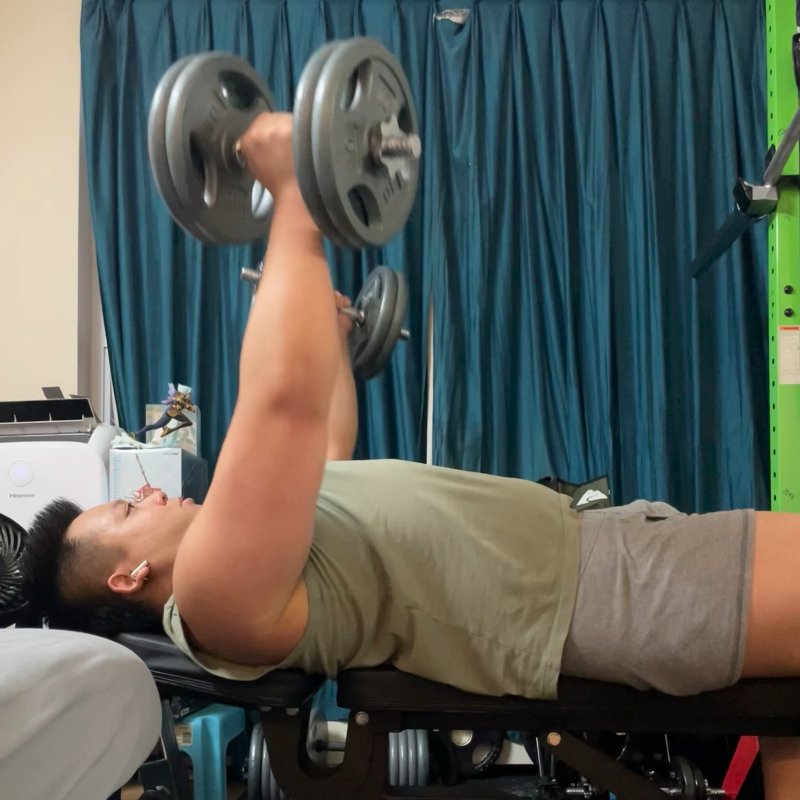
Log in to watch video demonstrations
Login to Watch2 video demonstrations available
Tips from the Community
-

Bring dumbbells down to your ears and make sure to squeeze on the way up.
Track your progress with Gravitus
Download Gravitus to log your workouts, track your progress, and join a community of fitness enthusiasts.

Helpful Resources
One Rep Max Calculator
Find your one rep max for any exercise without maximal testing. Essential for developing effective strength training programs.
Calculate 1RMWorkout Programs
Follow structured workout programs created by fitness professionals to maximize your strength and muscle gains.
View Programs